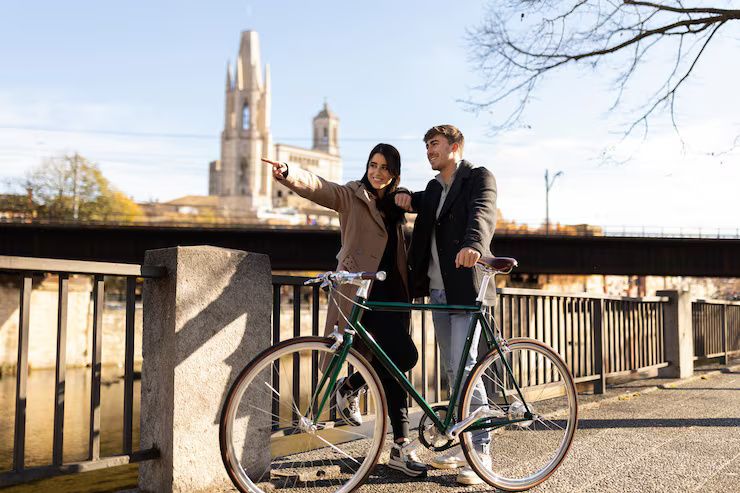Cycling tours across Europe have become a popular way for travelers to combine physical activity with cultural exploration. These tours offer an opportunity to experience diverse landscapes, from the vineyards of France and the canals of the Netherlands to the coastal paths of Spain and the mountainous routes of the Alps. Unlike traditional sightseeing by bus or train, cycling allows a slower, more immersive journey, giving riders the chance to engage closely with local communities and scenery.
Many European countries have developed extensive cycling infrastructure, including dedicated bike paths, signage, and accommodation designed specifically for cyclists. As a result, both beginners and experienced riders can find routes that suit their skill level and interests.

Importance
Cycling tours offer multiple benefits:
-
Sustainable Travel: With the growing emphasis on reducing carbon emissions, cycling offers an eco-friendly alternative to traditional transport.
-
Health and Fitness: Riders benefit from cardiovascular exercise while enjoying the outdoors.
-
Cultural Immersion: Slower travel speeds allow deeper engagement with local traditions, cuisine, and history.
-
Economic Impact: Cycling tourism supports small businesses such as cafes, guesthouses, and local bike shops.
For travelers, cycling tours can solve common travel problems, such as limited mobility in rural areas, high transportation costs, and the challenge of staying active while on holiday.
Recent Updates
In the past year, several European cycling initiatives have expanded or been improved:
-
EuroVelo Network Expansion (2024): New sections of EuroVelo 1 (Atlantic Coast Route) and EuroVelo 6 (Rivers Route) have been completed, improving cross-border connections.
-
E-Bike Accessibility: Many tour operators now include e-bike options, making longer or more challenging routes accessible to a wider audience.
-
Cycling-Friendly Accommodations: Countries like Germany and Austria have introduced updated certification systems for hotels and guesthouses catering to cyclists.
-
Digital Navigation Tools: Platforms such as Komoot and Ride with GPS have integrated more detailed European cycling maps and safety alerts.
Laws or Policies
Cycling tours in Europe are influenced by local and EU-level regulations:
-
Helmet Laws: Vary by country; for example, helmets are mandatory for children in France and Spain, while in the Netherlands they are not legally required for any age.
-
Road Sharing Rules: In most European countries, cyclists are expected to ride in bike lanes where available and follow the same traffic laws as vehicles.
-
Cross-Border Travel: Schengen Zone countries allow seamless cycling across borders without passport checks, but travelers should still carry identification.
-
Cycling Infrastructure Funding: The EU supports cycling projects through programs like the European Regional Development Fund, improving safety and route availability.
Tools and Resources
Cyclists can benefit from various resources to plan and manage their tours:
Apps and Navigation
-
Komoot – Custom route planning with terrain details.
-
Ride with GPS – Advanced route tracking and navigation.
-
Strava – Community-based route sharing and performance tracking.
Websites and Route Databases
-
EuroVelo (eurovelo.com) – Official routes across Europe.
-
Cycling UK – Route guides and cycling advice.
-
Bikemap – Interactive cycling maps with user-generated content.
Equipment and Support
-
Local bike rental shops often provide touring bikes and e-bikes.
-
Pannier and gear rental is available in most major cycling hubs.
Popular Cycling Tours Across Europe (Sample Table)
| Route Name | Countries Covered | Distance (Approx.) | Highlights |
|---|---|---|---|
| Danube Cycle Path | Germany, Austria, Hungary | 1,200 km | Castles, vineyards, river scenery |
| EuroVelo 6 | France to Romania | 4,450 km | Rivers Loire, Rhine, and Danube |
| Loire Valley | France | 800 km | Châteaux, wine regions |
| Camino de Santiago | Spain | 800 km | Pilgrimage route, historic towns |
| Amsterdam to Bruges | Netherlands, Belgium | 400 km | Canals, windmills, medieval cities |
| Ring of Kerry | Ireland | 200 km | Coastal cliffs, Irish countryside |
FAQs
Q1: Do I need to be very fit to join a European cycling tour?
Not necessarily. Many routes offer e-bike rentals, and tours can be tailored to beginner, intermediate, or advanced levels.
Q2: Can I bring my own bike on European trains?
Yes, but policies vary. Many long-distance trains require a bike reservation, while regional trains often allow bikes without extra cost.
Q3: What is the best season for cycling tours in Europe?
Spring (April–June) and early autumn (September–October) offer mild temperatures and fewer crowds.
Q4: Is travel insurance necessary for cycling tours?
Yes. Choose a policy that covers medical expenses, trip cancellations, and cycling-related accidents.
Q5: Are guided tours better than self-guided tours?
It depends on preference. Guided tours offer support and logistics management, while self-guided tours provide more flexibility.
Final Thoughts
Cycling tours across Europe provide a unique blend of adventure, exercise, and cultural immersion. With improved cycling infrastructure, growing e-bike availability, and cross-border accessibility, it has never been easier to explore the continent on two wheels. Whether following the Danube’s gentle river paths or tackling the challenging climbs of the Alps, riders can find routes that match their skill level and interests. By preparing with the right tools, understanding local cycling laws, and choosing the right season, travelers can make the most of Europe’s world-class cycling opportunities.